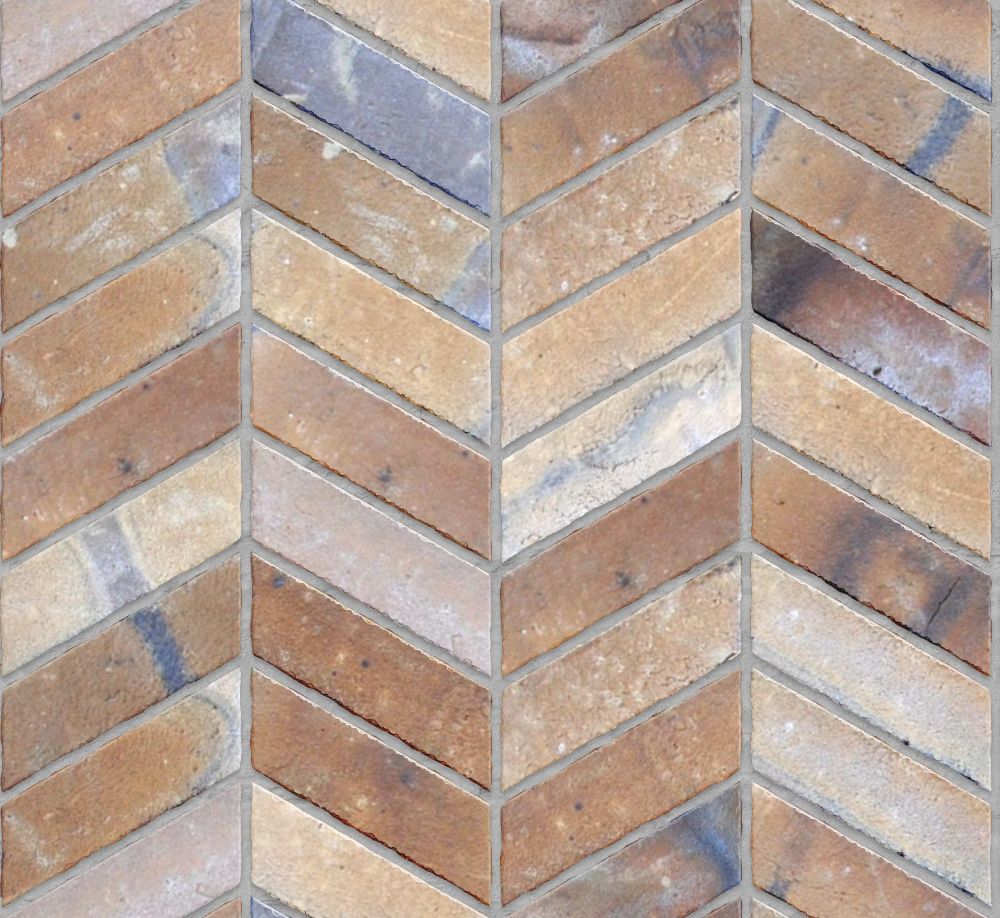Burnt Clay Bricks Chevron
Category
Brick
Download
Edit
Bricks are one of the most common materials in architecture and construction. With recorded uses dating back over 9000 years, brick traces its origins to mud and straw adobe blocks as found in Africa, southern Asian and southern American regions where hot, dry climates quickly dried and cured the earth bricks naturally in the heat. Clay bricks were used extensively throughout the Roman Empire thanks to the Romans’ invention of the mobile kiln, an innovation on the kiln used by ancient Egyptian builders to fire clay mixtures when placed in moulds, which enabled brick manufacture across Rome’s territories, using an increased range of local clay and soil compositions. Bricks were then regularly used in Europe from around the 12th century, when northern European countries traded materials, knowledge and design ideologies with Italy during the Gothic and Renaissance eras, spreading the use of Roman designs and construction methods, until dying out for a period due to bricks’ inability to recreate the intricate shapes of ornament and decoration associated with these styles.
The exploration of new forms and manufacturing methods seen a return to popularity, combined with their increasingly popular reputation as a replacement to timber in densely populated cities in the 17th century, particularly London, due to their far superior fire retarding properties, following a spate of particularly serious, destructive urban fires that ripped through older timber building stock. Other cities followed suit during the 18th century industrial revolution as bricks proved a hardy, enduring, cost effective, simple to construct, reliable, impervious, consistently dimensioned building unit protecting against damp air and wet ground conditions, especially after the invention of fast, mass manufacturing techniques. Brick was then popularised in northern America and other English, Belgian, Dutch, French, Spanish and Portuguese territories, through early émigrés taking their masonry skills abroad.
They remain popular due to their readily available raw materials, simple manufacture, low cost, ease of maintenance, basic-skilled assembly and attractive variety of colours, textures and finishes. Modern brick can be cut to standard sizes to form a versatile, durable building product, or specially manufactured to suit a variety of angles, curves and unique shapes for decorative purposes on organic forms. Hard-wearing and with excellent structural and thermal properties, they are a popular, efficient, human-scaled material for paving, load-bearing walls, cladding systems, landscaping and interior decorative walls, while a variety of finishes and palettes within the one product can create rustic, weathered, industrial aesthetics increasingly popular in bespoke, contemporary domestic, hospitality and workplace environments; practical, perfunctory settings; or decorative façades. Preferred for their domestic, human scale, bricks are one of the easiest construction materials to handle and build with when combined and laid with cementitious mortars. They are well suited to domestic, care, primary education and community building types in all climatic settings provided they are manufactured correctly and to the right specifications with respect to their locale.
Burnt clay bricks are amongst the most traditional form of brick, displaying a rich variety of natural colours due to the chemical properties of the clay used, ranging from silvers, blues and flecks of white to yellows, oranges, reds and burnt brown. The bricks have a slightly rough, worn surface texture, which is desired for creating rustic aesthetics, or to match older, weathered brick on existing buildings. The range of colours make this particular brick useful for tying into existing projects, or to stand out against neutral bricks or less vibrant materials. The combination of deep navy and grey-blues with sandy, golden and rust tones creates a pleasantly gentle warm, mellow, feel. Clay bricks are an ideal material for use on domestic, healthcare and education façades and interiors due to their human scale and reassuring, natural colours and radiant warmth, or for large scale projects as they are cheap to produce and lay on site.
A seamless brick texture with burnt clay bricks arranged in a chevron pattern. Seamless textures can be tiled repeatedly across a surface without visible seams making them useful for architectural drawings and 3D models. This image can be used as a SketchUp texture, Revit material or imported into Photoshop for use in 2D illustrations. A high resolution version of this texture is available, as well as CAD hatches and PBR maps with Architextures Pro.

